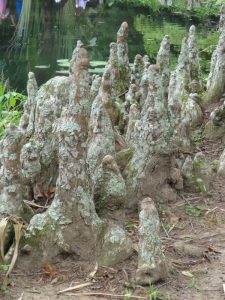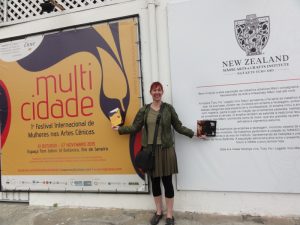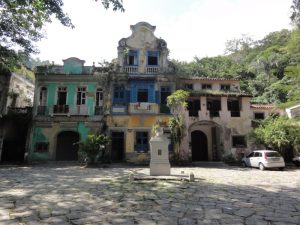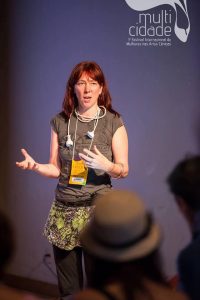 Who would have thought i’d find my way onto page 2 of Brasil’s largest newspaper, O Globlobo? But there I am, staring mysteriously out of a computer screen beside an edited version of my life story. The full article is online here – in Português, naturally.
Who would have thought i’d find my way onto page 2 of Brasil’s largest newspaper, O Globlobo? But there I am, staring mysteriously out of a computer screen beside an edited version of my life story. The full article is online here – in Português, naturally.
I was interviewed for O Globo in my capacity as a visiting artist at the Multicidade International Festival of Women’s Performance in Rio de Janeiro, 31 October – 7 November, a Magdalena festival where I created and presented a new “We have a situation!” event. This involved a week-long workshop with local participants, as well as work over the previous months with a team of 5 online cyberformers. Our topic was water pollution, in the particular context of the approaching 2016 summer Olympics to be held in Rio. It is a pretty dire situation, with high percentages of the city’s sewage going directly into the bay, industrial pollution and general rubbish; despite making promises to clean it up in order to win the Olympic bid, the authorities have made little effort. Of course, the problem is much deeper and more difficult than can be solved in the next six months. There is information and documentation of the project here, and documentation from the festival here.
Knowing that this would be a busy time for me, I arrived a week early to prepare my work and do a bit of sight-seeing. I’d never been to Rio before so I wanted to get a feel for the place, and I started by reading Juliana Barbassa’s recently published book “Dancing with the Devil in the City of God” on the plane over. I recommend it for anyone interested in the history and contemporary social, political, economical and environmental situation of Rio de Janeiro. it’s an excellent first-hand account from a writer who is both an insider and yet also an outsider, so able to present a very clear perspective across a variety of issues.
 On my first day in Rio, I met Regina Célia Pinto and we visited Rio’s historic Jardim Botânico (Botanical Garden), which was literally across the street from where I was staying the first week. Established in 1808 and covering 137 hectares, the garden is full of amazing plants and wildlife. I became fascinated by the variety of roots to be found – smooth roots that emerge a long way up the trunk to descend like gracefully folded curtains or thick long ropes, knobbly roots that erupt from the ground around the trunk, fat crocodile-shaped roots that lie lazily half-submerged in the grass, and roots that look like works of modern art. Then there’s the fruit – such as the lumpy bags of jackfruit dangling like fleshy apendages, or the decorative balls and flowers of the monkey apricot tree. And of course all manner of birds, scampering little monkeys, grand collondades of palms, antique fountains. We wandered for nearly four hours in the gardens. The festival venue, Espaço Tom Jobim (named after the composer of “The Girl from Ipanema”) is also located at the Jardim Botânico, so this was the area I would spend the most time in Rio.
On my first day in Rio, I met Regina Célia Pinto and we visited Rio’s historic Jardim Botânico (Botanical Garden), which was literally across the street from where I was staying the first week. Established in 1808 and covering 137 hectares, the garden is full of amazing plants and wildlife. I became fascinated by the variety of roots to be found – smooth roots that emerge a long way up the trunk to descend like gracefully folded curtains or thick long ropes, knobbly roots that erupt from the ground around the trunk, fat crocodile-shaped roots that lie lazily half-submerged in the grass, and roots that look like works of modern art. Then there’s the fruit – such as the lumpy bags of jackfruit dangling like fleshy apendages, or the decorative balls and flowers of the monkey apricot tree. And of course all manner of birds, scampering little monkeys, grand collondades of palms, antique fountains. We wandered for nearly four hours in the gardens. The festival venue, Espaço Tom Jobim (named after the composer of “The Girl from Ipanema”) is also located at the Jardim Botânico, so this was the area I would spend the most time in Rio.
 Coincidentally, an exhibition of Maori art, Tuku Iho, was at the same venue as the festival, finishing on my first day in Rio so I was luckily able to see it. It was great to see all the taonga in the same space that, two weeks later, I would perform in.
Coincidentally, an exhibition of Maori art, Tuku Iho, was at the same venue as the festival, finishing on my first day in Rio so I was luckily able to see it. It was great to see all the taonga in the same space that, two weeks later, I would perform in.
Before coming to Rio, I had made contact with Haveté Sustentabilidade (“haveté” is a local indigenous word for being grateful), a group of four young women promoting sustainability at a grassroots level. They work with local communities on various issues, including recently on water sustainability, and had been very helpful with research and information on the topic of water pollution prior to my arrival. They offered to organise a boat trip with a local fisherman and water activist, who could take me around Guanabara Bay to show me sights of pollution and explain the problems from his perspective. We spent a lot of time of the next days planning and then postponing this trip – first on account of the weather, and then when there was finally a perfect day Rafaella, who would translate for us, was sick. It was a shame not to be able to make this trip, but the workshop participants were so enthusiastic and brought so much information and ideas that we had no shortage of material for creating the performance.
 The first week passed quickly. I was interviewed for the O Globo article and met with kiwi journalist Laura McQuillan; I went up to the giant statue of Christ and, pressed between the other tourists, gazed out at the panoramic views; Regina and I walked on Ipanema Beach and drank coconuts; and with the help of Fernandez, one of the festival’s drivers, I managed to get to the beautiful Largo do Boticário, where the Rio Carioca can be glimpsed in its culvert. This river, once the main source of pure drinking water for the city and revered by local Indians for giving men strength and women beauty, is today largely buried in culverts and pipes beneath the city and is so polluted that a sewage treatment plant has been built where its waters run into Guanabara Bay. This river also gives its name to Rio’s citizens, who are known as Cariocas. Largo do Boticário is a quiet and peaceful place, just off a busy road and dominated by a beautifully dilapidated once-grand mansion; it was a good place to contemplate the city’s history and current context.
The first week passed quickly. I was interviewed for the O Globo article and met with kiwi journalist Laura McQuillan; I went up to the giant statue of Christ and, pressed between the other tourists, gazed out at the panoramic views; Regina and I walked on Ipanema Beach and drank coconuts; and with the help of Fernandez, one of the festival’s drivers, I managed to get to the beautiful Largo do Boticário, where the Rio Carioca can be glimpsed in its culvert. This river, once the main source of pure drinking water for the city and revered by local Indians for giving men strength and women beauty, is today largely buried in culverts and pipes beneath the city and is so polluted that a sewage treatment plant has been built where its waters run into Guanabara Bay. This river also gives its name to Rio’s citizens, who are known as Cariocas. Largo do Boticário is a quiet and peaceful place, just off a busy road and dominated by a beautifully dilapidated once-grand mansion; it was a good place to contemplate the city’s history and current context.
Just before the intensity of the festival descended, I managed to have another wander around Santa Teresa, seeing the Parque des Ruinas and neighbouring museum; and with some of the other Magdalenas bravely rode the cable car up to the top of the Sugarloaf, for more stunning views. We were lucky to have a sunny day – once the festival began it rained nearly every day, torrential downpours that quickly created puddles around the theatre and rivers in the streets. Water problems in Rio are not confined to pollution! As well as the spectacular rain, the humidity is such that there is a always a faint whiff of mouldiness and even clothes that I hadn’t worn felt slightly damp to the touch.
 There is a lot more to say about my time in Rio – it was a fantastic festival and great to discover the city a little bit – but I will never finish this post if I don’t stop soon. Maybe I’ll write more later – but already I’m refocussing to work on the next project (Unaussprechbarlich, with Annie Abrahams) and I know I’ll have little time before the end of the year. If you want to know more about it all, please look at these sites:
There is a lot more to say about my time in Rio – it was a fantastic festival and great to discover the city a little bit – but I will never finish this post if I don’t stop soon. Maybe I’ll write more later – but already I’m refocussing to work on the next project (Unaussprechbarlich, with Annie Abrahams) and I know I’ll have little time before the end of the year. If you want to know more about it all, please look at these sites: